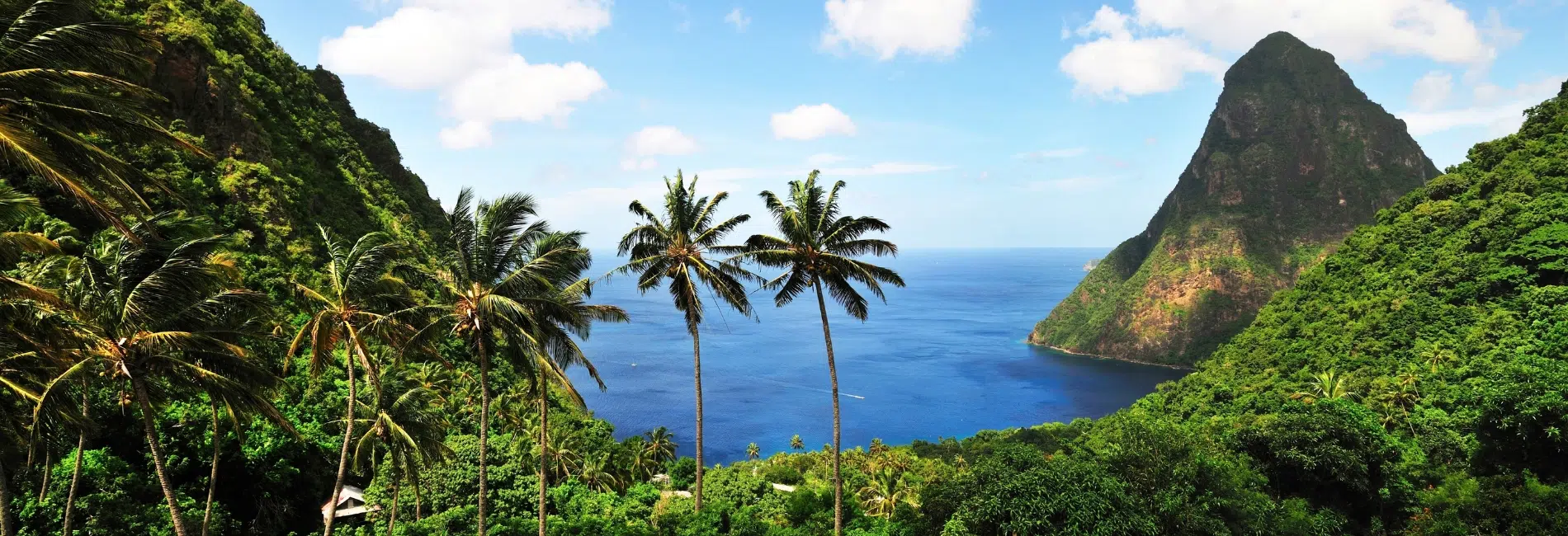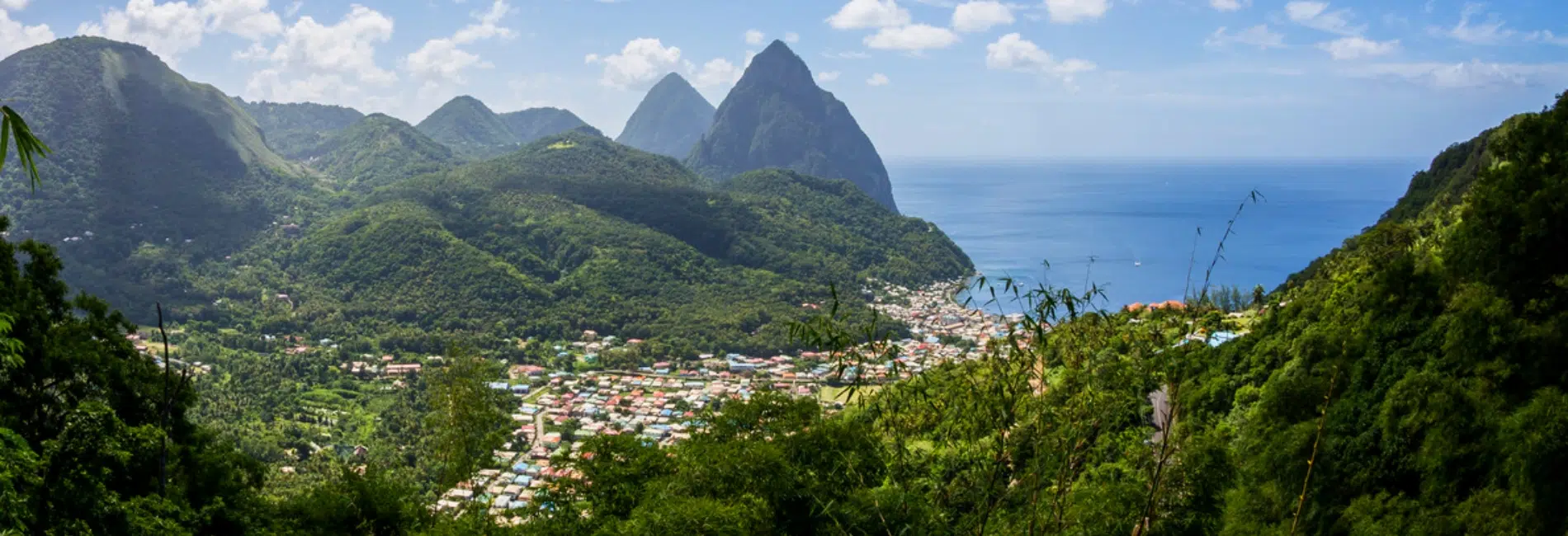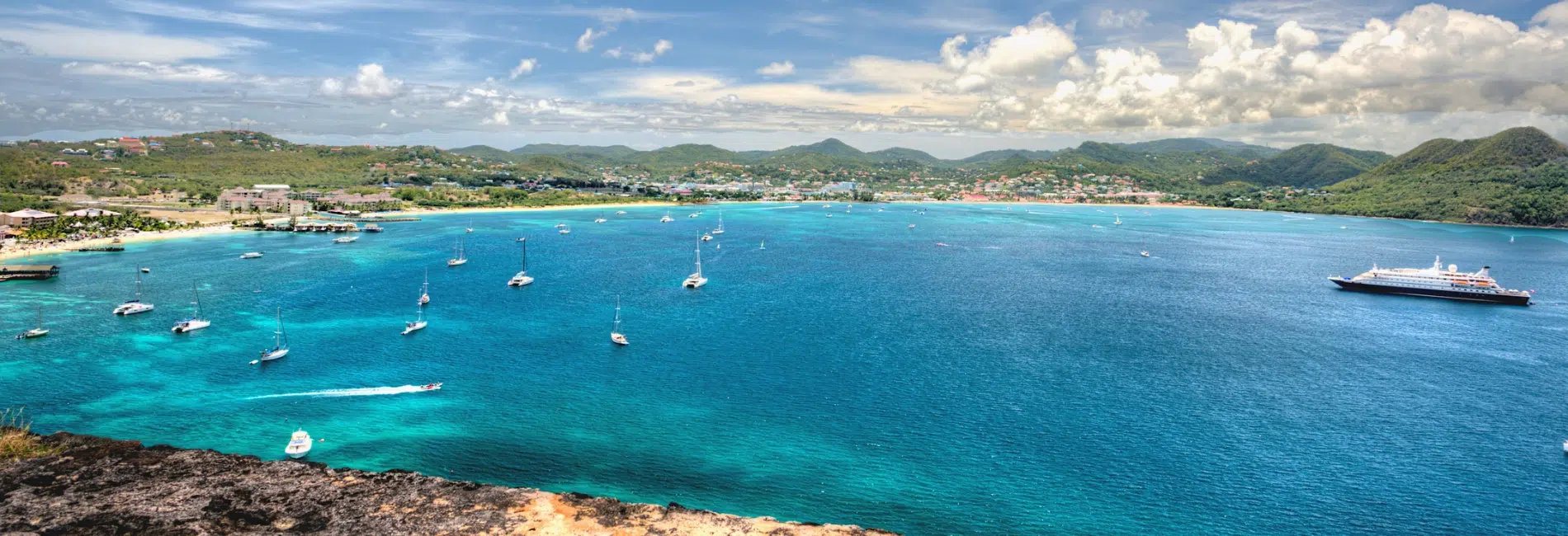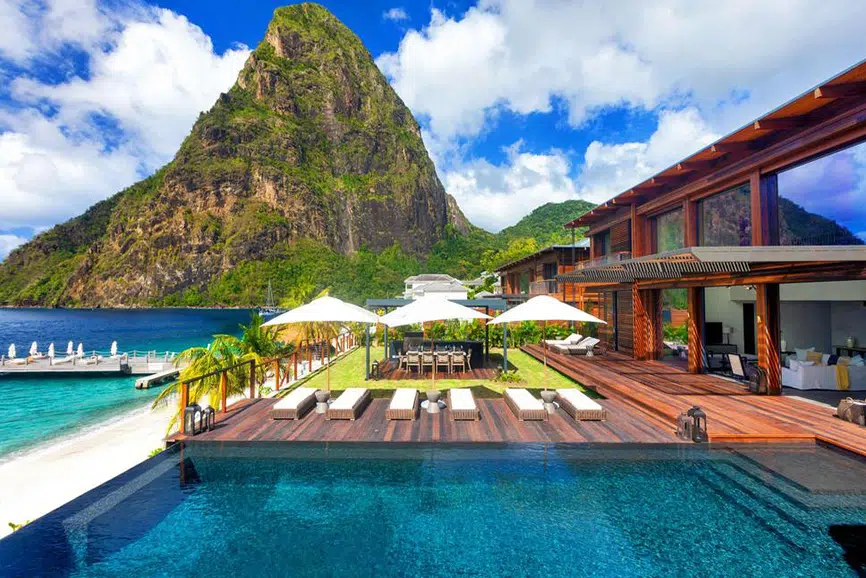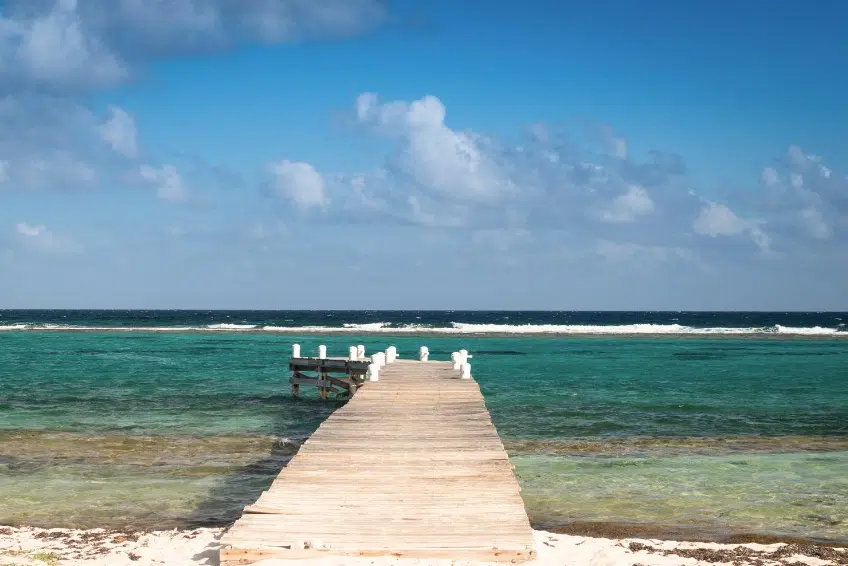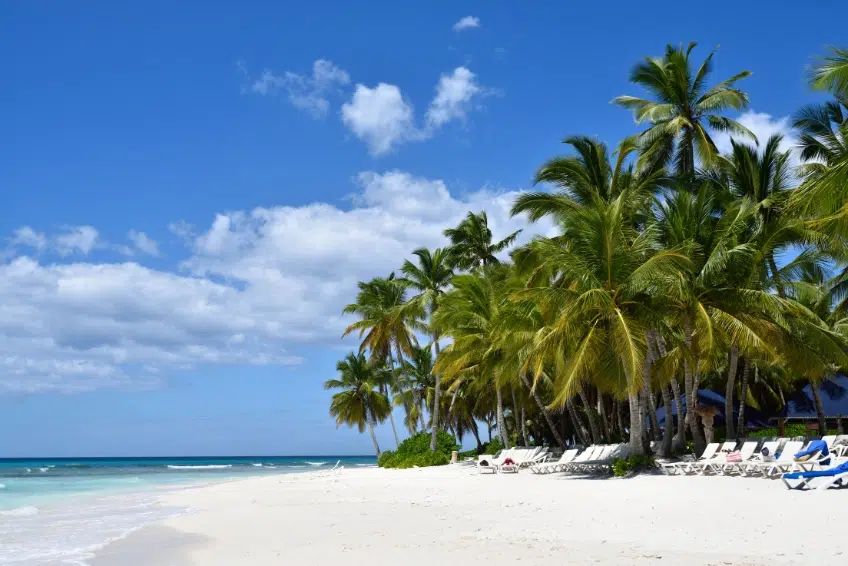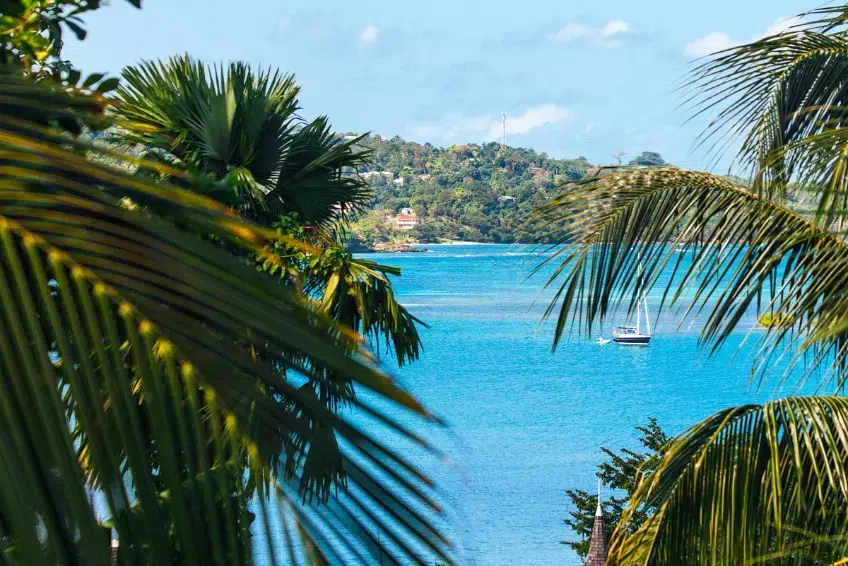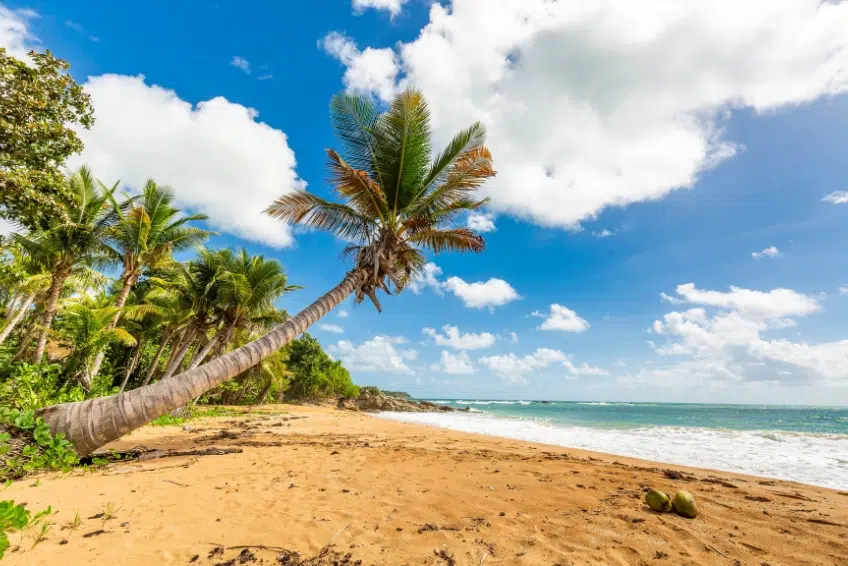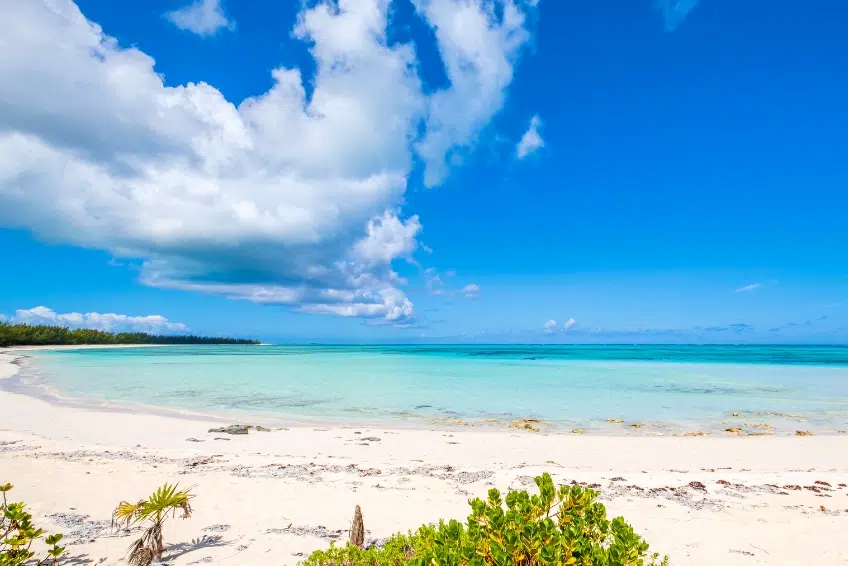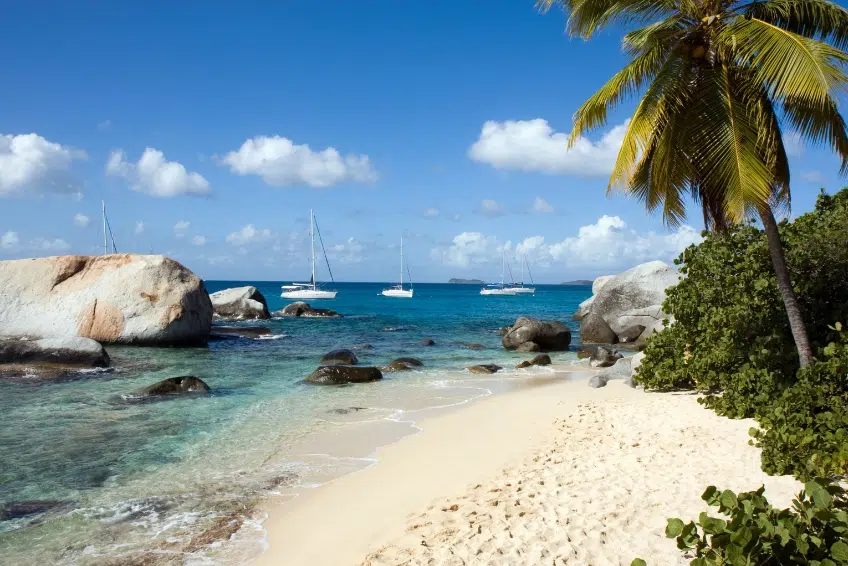
The Pitons
Picture yourself standing between two ancient volcanic spires that rise dramatically from the Caribbean Sea, their peaks reaching toward tropical clouds while pristine beaches stretch below. These are the Pitons, St. Lucia’s UNESCO World Heritage icons that have watched over this 238-square-mile island for over 200,000 years. But St. Lucia offers far more than postcard-perfect views. This Eastern Caribbean gem has earned the title of World’s Leading Honeymoon Destination for the 16th time in 2024, building its reputation on a foundation of luxury resorts, authentic Caribbean culture, and adventures that range from rainforest zip-lining to diving pristine coral reefs. You’ll find St. Lucia delivers experiences that other Caribbean islands struggle to match. Where else can you drive through a volcano in the morning, soak in mineral-rich hot springs after lunch, and watch the sunset from your private infinity pool overlooking the Caribbean Sea?

Castries
The island’s French and British colonial heritage creates a unique cultural blend where you’ll hear both English and French Creole spoken in colorful fishing villages, taste cacao straight from rainforest trees, and join locals for Friday night street parties that have been running for over 50 years. The numbers tell part of the story: St. Lucia welcomes over 400,000 overnight visitors annually, who discover 98 miles of coastline, waterfalls cascading through tropical rainforests, and luxury resorts where butler service and private plunge pools are the standard, rather than the exception. But the real magic happens when you experience the warmth of St. Lucian hospitality, whether you’re sharing rum punch with your hiking guide after conquering Gros Piton or learning to make traditional green fig and saltfish from a local grandmother.
Contents
St. Lucia At A Glance

Location
Located in the Eastern Caribbean’s Windward Islands, St. Lucia sits 21 miles south of Martinique and 24 miles north of Saint Vincent.
This volcanic island stretches 27 miles long and 14 miles at its widest point, packing remarkable diversity into its 238 square miles. The population of 180,000 residents lives predominantly in rural communities, with the capital city Castries serving as the commercial hub while smaller towns like Soufriere and Vieux Fort maintain their fishing village charm.
Explore St. Lucia Travel Planning & Insider Tips

Language & Currency
English serves as the official language, though you’ll hear Saint Lucian French Creole (Kwéyòl) spoken by 95% of the population. A melodic blend of French, West African languages, and English that reflects the island’s complex colonial history.
The Eastern Caribbean Dollar (EC$) is the official currency, fixed at 2.70 to one US dollar since 1976. Although American currency is widely accepted in tourist areas, change is typically given in EC$.
Explore St. Lucia Travel Planning & Insider Tips

Climate
The tropical climate keeps temperatures comfortable year-round, ranging from 76°F to 87°F, with northeast trade winds providing natural air conditioning. You’ll encounter two distinct seasons: the dry season, from December through May, sees only 2-4 inches of monthly rainfall, while the wet season, from June through November, brings brief afternoon showers and monthly rainfall of 7-10 inches.
Hurricane season officially runs from June through November, though St. Lucia’s position means it rarely sees direct hits. Only 14 hurricanes have passed within 60 miles since 1850.
Explore St. Lucia Travel Planning & Insider Tips

Flights
Most international flights arrive at Hewanorra International Airport (UVF) in the south, though regional flights use the smaller George F.L. Charles Airport (SLU) near Castries, just minutes from northern resorts.
Direct Flights From US & Canada
- Miami (3 hours) – American Airlines, JetBlue
- Atlanta (4 hours) – Delta
- New York JFK (4.5 hours) – JetBlue, Delta
- Charlotte (3.5 hours) – American Airlines
- Philadelphia (5 hours) – American Airlines
- Chicago (5.5 hours) – United
- Toronto year-round (5 hours 20 minutes) – Air Canada, WestJet
- Montreal (seasonal winter service) – Air Canada
Explore St. Lucia Travel Planning & Insider Tips
Why Choose St. Lucia?

The Pitons
St. Lucia’s twin Pitons define the island’s identity in ways that extend far beyond their photogenic profiles. These towering volcanic plugs (Gros Piton at 2,619 feet and Petit Piton at 2,438 feet) anchor a 7,190-acre UNESCO World Heritage Site that encompasses both land and sea. The Pitons Management Area protects 168 fish species, 60 types of coral, and 148 plant species, creating one of the Caribbean’s most biodiverse regions.
You can hike Gros Piton with a mandatory guide for $50 USD; however, the challenging 3-6 hour trek requires good fitness levels as you gain 2,000 feet over steep, rocky terrain.
Explore St. Lucia Activities & Things To Do
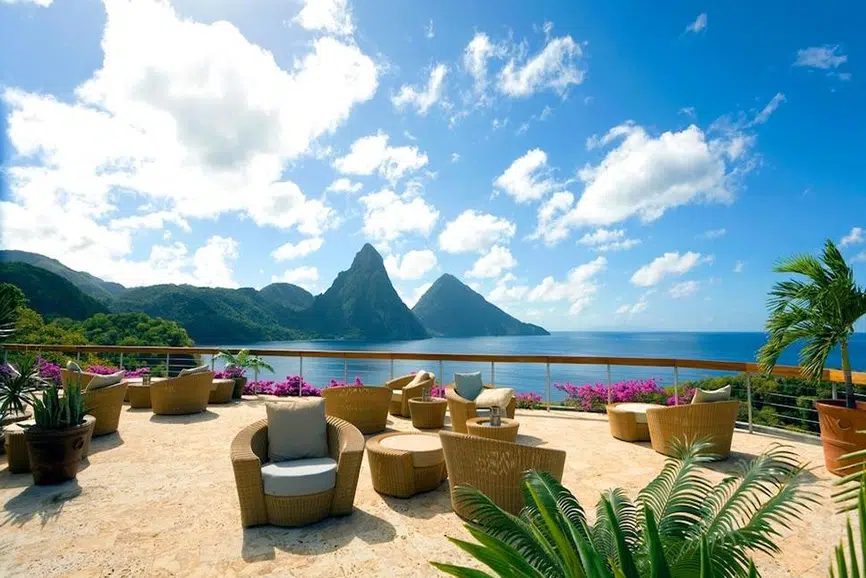
Luxury Resorts
The island’s luxury resort reputation extends well beyond awards and accolades. Properties like Jade Mountain have redefined Caribbean luxury with their revolutionary architecture, as each of the 29 sanctuaries features only three walls, opening completely to Piton views with private infinity pools that seem to float in mid-air.
Room rates here range from $1,500 to $5,000 per night, but you’re paying for an experience that exists nowhere else on earth. Ladera Resort claims the distinction of being the only resort located directly on the UNESCO World Heritage Site, while Sugar Beach nestles between both Pitons on a pristine white sand beach.
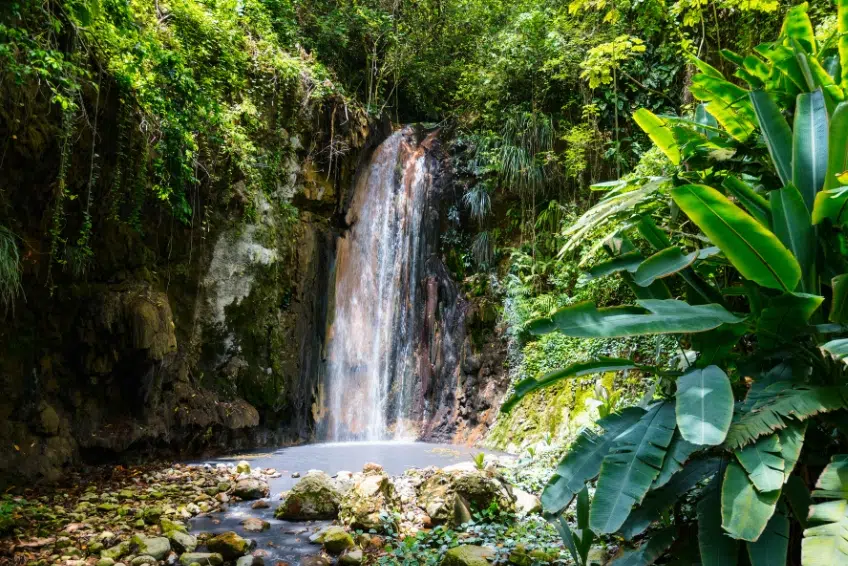
Nature & Wildlife
Adventure seekers find that St. Lucia delivers experiences that satisfy both adrenaline junkies and casual explorers. The island’s volcanic origins have created a landscape perfect for adventure. You can zip-line through rainforest canopy at 2,000 feet elevation, explore the Caribbean’s only drive-in volcano at Sulphur Springs, or snorkel directly from shore at Anse Chastanet, where the reef begins just 10 yards from the beach.
Dive operators like Scuba St. Lucia offer PADI certification courses and access to sites ranging from the wreck of the Lesleen M to drift dives along the Piton walls, where you might spot eagle rays and sea turtles.
Explore St. Lucia Activities & Things To Do Guides

Culture
Unlike some Caribbean islands that feel manufactured for tourism, St. Lucia maintains its authentic character through strong cultural traditions:
- Friday Night Jump-ups: Gros Islet’s 50+ year tradition brings locals and visitors together for street food, music, and dancing until dawn
- Creole Heritage: October’s Jounen Kwéyòl celebrates French Creole culture with island-wide festivals
- Carnival Season: July’s festivities rival Trinidad for energy with steel pan competitions and elaborate costumes
- Culinary Traditions: Family recipes for green fig and saltfish (the national dish) passed down through generations
- Local Markets: Authentic interactions with vendors selling fresh produce, spices, and handcrafted goods
Explore St. Lucia Travel Planning & Insider Tips
St. Lucia Guides Directory

Hotels and Resorts
St. Lucia’s accommodation landscape divides into distinct personalities across the island. In Soufrière, ultra-luxury properties command $1,500-5,000 nightly for architecture that erases boundaries between indoor and outdoor living. Rodney Bay offers the widest variety, from $86-per-night guesthouses to all-inclusive resorts where butler service and premium spirits are standard. Three Sandals properties provide adults-only experiences with exchange privileges that give you access to 27 restaurants across their St. Lucian resorts. Families gravitate toward Coconut Bay’s 85-acre property featuring water slides, a lazy river, and a separate adults-only section. For those seeking privacy, over 1,300 villa rentals and Airbnb style rentals range from $75-per-night apartments to fully-staffed estates with private chefs.

Activities and Things To Do
Every day in St. Lucia presents choices between relaxation and adventure. Morning catamaran cruises along the west coast include snorkeling stops and rum punch for around $75-145 USD, while certified divers can explore 60 documented dive sites, including night dives twice weekly. The rainforest canopy becomes your playground on zip-line courses near Castries, where 11 cables send you flying through tropical forest at heights up to 2,000 feet. Cultural experiences run deeper than typical tourist offerings. At St. Lucia Distillers, the “Rhythm of Rum” tour includes tastings of 25 different rums, while Hotel Chocolat’s tree-to-bar experience has you making chocolate from cacao pods you harvest yourself.
Explore St. Lucia Activities & Things To Do
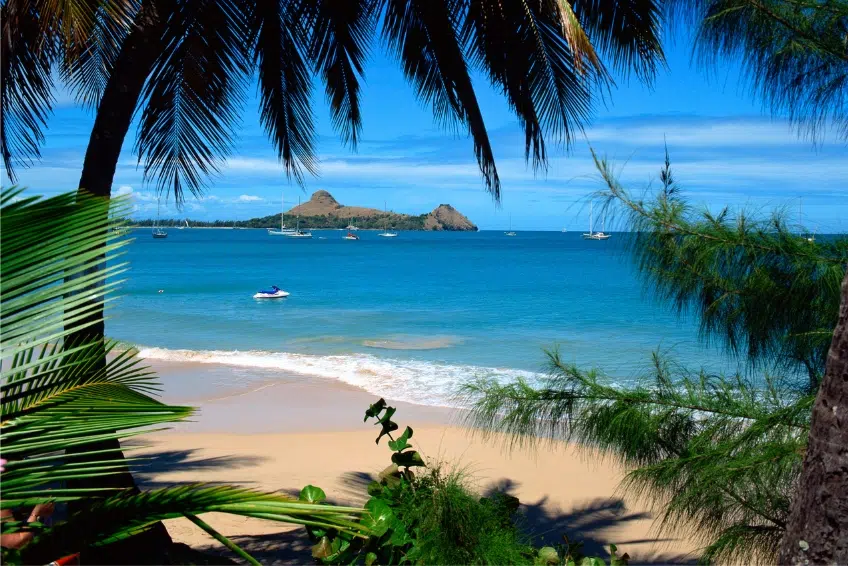
Beaches
Each of St. Lucia’s beaches offers distinct characteristics that go beyond sand and sea. Reduit Beach in Rodney Bay stretches for a mile with calm waters perfect for families, plus water sports rentals and beachfront restaurants. Sugar Beach sits dramatically between the Pitons, its imported white sand contrasting with the volcanic black sand found naturally in the area. Anse Chastanet combines excellent snorkeling with a relaxed atmosphere, though you’ll pay for day passes if you’re not a resort guest. For authentic local flavor, visit Anse La Raye on Friday evenings when the fishing village transforms into an outdoor seafood festival.
Explore St. Lucia Beaches

Restaurants & Cuisine
Dining in St. Lucia ranges from street-side bakes (fried bread sandwiches) for $2 USD to elaborate tasting menus at clifftop restaurants. In Soufrière, Dasheene at Ladera serves contemporary Caribbean cuisine with ingredients sourced from their own organic farm. Rodney Bay’s restaurant row includes The Cliff at Cap Maison, where French-Caribbean fusion comes with sunset views over Martinique. Don’t miss the local spots. In Castries Market, vendors serve hearty portions of stewed chicken with rice and peas for under $10 USD. Most restaurants automatically add a 10% service charge and 10% VAT to bills. Small extra cash tips are recommended for great service.
Explore St. Lucia Restaurants and Local Food

Travel Planning
Your St. Lucia experience depends significantly on timing and preparation. The electronic immigration form must be completed within three days of arrival. One form covers your entire family and generates a QR code for expedited entry. Paper backups are available, but they will significantly slow down the process. U.S. citizens need only a passport valid for the duration of their stay, while Canadians require a passport with three months’ validity beyond their departure date. No visa is required for stays up to six weeks. Travel insurance isn’t mandatory, but it proves essential given the limited medical facilities. The island’s best private hospital requires upfront payment, and serious conditions often require medical evacuation to Miami or Martinique.
Explore St. Lucia Travel Planning & Insider Tips
Essential Planning Information

Entry Requirements
- US Citizens: Passport valid for the stay duration only
- Canadian Citizens: Passport valid for 3 months beyond departure
- Visa: Not required for stays up to 6 weeks
- Electronic Form: Mandatory immigration form (complete within 3 days of arrival)
- Proof Required: Onward travel and accommodation details
US and Canadian citizens enjoy straightforward entry to St. Lucia, though requirements differ slightly between nationalities. The electronic immigration form, which is mandatory for all air arrivals, opens three days prior to travel and must be completed online. The system generates a QR code, which significantly speeds up the arrival processing.
Explore St. Lucia Travel Planning & Insider Tips

Transportation Options
- Private Transfers: $90 USD from UVF airport (90 minutes to northern resorts)
- Rental Cars: $50-60 USD daily (plus $20 for a 3-month temporary driving permit)
- Taxis: Light blue “TX” plates, negotiate fare in advance (no meters)
- Helicopter Transfers: $200+ per person for scenic route to resorts
Transportation around St. Lucia requires advanced planning, as the island’s mountainous terrain and winding roads can be a surprise to first-time visitors. Many visitors find the mountain roads challenging, particularly the route between Castries and Soufriere, so taxis and pre-arranged transfers often prove more relaxing than renting a car.
Explore St. Lucia Travel Planning & Insider Tips

Money
Money matters in St. Lucia may require carrying both US dollars and Eastern Caribbean dollars for different situations. While major hotels and restaurants accept US dollars, you’ll receive change in EC$, and local vendors often only accept the local currency. ATMs throughout the island dispense EC$ at competitive exchange rates, although your bank may charge international transaction fees.
Credit cards work at established businesses, but you’ll need cash for markets, street vendors, and tips. The 10% service charge added to many restaurant bills doesn’t always reach staff directly, so leaving additional cash ensures your server benefits from your tip.
Explore St. Lucia Travel Planning & Insider Tips

Safety
Safety in St. Lucia follows common-sense Caribbean travel guidelines. The US State Department maintains a Level 1 advisory (Exercise Normal Precautions), the lowest risk category. Petty crime exists, particularly pickpocketing in crowded markets and bag snatching in Castries after dark. The capital city experiences the majority of incidents, so it is advisable to use taxis at night and avoid displaying expensive jewelry or large amounts of cash.
Vieux Fort has experienced increased gun violence, though this rarely affects tourists. The island’s 84% rural population maintains strong community bonds, which contribute to visitor safety. However, solo female travelers should exercise additional caution, particularly on isolated beaches.
Explore St. Lucia Travel Planning & Insider Tips

Seasons
St. Lucia’s weather patterns create distinct travel experiences throughout the year. The dry season from December through May brings near-perfect conditions with daytime temperatures of 83-86°F, minimal rainfall (2-4 inches monthly), and humidity around 73%. This period sees hotel rates spike 200-300% above low season, with peak pricing from December through March when North Americans escape winter.
The shoulder season in late April through June offers excellent value. You’ll save 30-50% on accommodations while enjoying great weather before the summer rains begin. Hurricane season officially runs from June through November, though St. Lucia’s risk remains relatively low. The wettest months of September and October see 8-10 inches of rain, typically falling in brief afternoon downpours that clear quickly. The low season from July through October delivers the best deals with savings up to 60% off peak rates, plus you’ll encounter fewer crowds at popular attractions.
Explore St. Lucia Travel Planning & Insider Tips

Calendar
- Saint Lucia Jazz & Arts Festival (Late April or Early May): International and Caribbean artists perform at Pigeon Island National Landmark.
- Carnival Season (Mid July): Steel pan competitions, calypso performances, and elaborate costume parades. The main parade is usually the 3rd Mon/Tue of July.
- Creole Heritage Month (October): Month-long celebration.
- Atlantic Rally for Cruisers (Late November): Hundreds of sailing vessels create a festive atmosphere in Rodney Bay Marina.
- Whale watching October through February when humpbacks migrate through St. Lucian waters.
- Sea Turtle Nesting occurs March through November, with peak activity July through September on eastern beaches.
- Slow Season Closures: Some smaller hotels close for maintenance in September and October, while restaurants may reduce hours during the slowest tourism periods.
Explore St. Lucia Travel Planning & Insider Tips
Local Culture & Etiquette
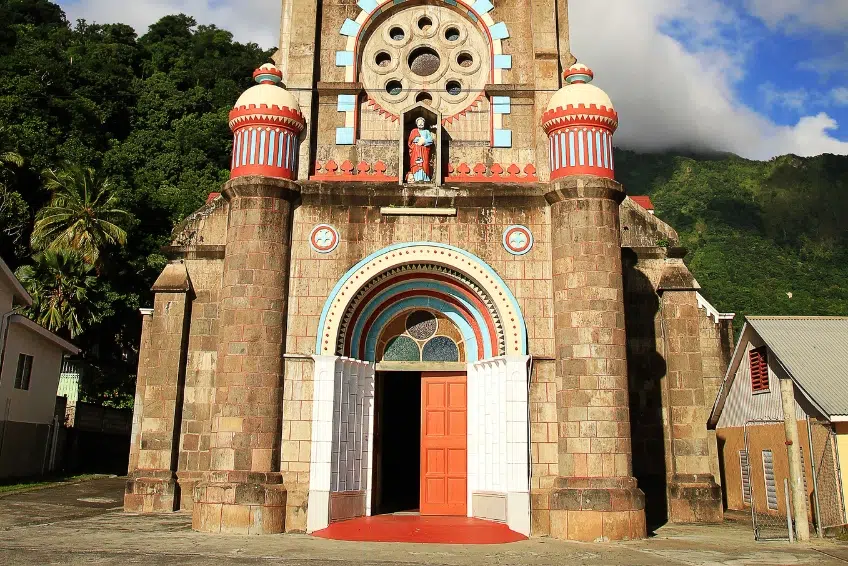
Essential Cultural Guidelines
- Greetings: Always say “Good morning,” “Good afternoon,” or “Good night” when entering establishments or passing people. Not reciprocating marks you as “unmannerly,” a serious social faux pas.
- Dress Code: Modest clothing away from beaches (topless sunbathing is illegal). The island’s 67.5% Catholic population maintains fairly conservative values.
- Social Timing: Expect “island time” with events starting 15-30 minutes late.
Explore St. Lucia Travel Planning & Insider Tips

Tipping Basics
Tipping customs follow North American standards with some local variations. Restaurants often add a 10% service charge, but leaving a little additional cash ensures servers receive your full gratuity. Hotel housekeeping staff typically appreciate $1-2 USD daily, while tour guides expect 10-15% of the tour cost.
At all-inclusive resorts, check the tipping policy. Some discourage the practice while others welcome it. In markets and with street vendors, bargaining is expected for crafts and souvenirs, with initial prices often inflated 50-100% for tourists. Start negotiations at half the asking price and settle somewhere in between.
Explore St. Lucia Travel Planning & Insider Tips

Language
The linguistic landscape reflects St. Lucia’s complex colonial history. While English serves as the official language for business and government, 95% of the population speaks Kwéyòl, a French-based Creole that sounds musical to foreign ears.
Learning basic phrases like “Bonjou” (hello), “Mési” (thank you), and “Souplé” (please) earns appreciation from locals. Many St. Lucians switch fluidly between languages. You might hear a vendor negotiating in Kwéyòl before turning to serve you in perfect English.
Explore St. Lucia Travel Planning & Insider Tips
St. Lucia FAQ
Frequently Asked Questions
Q: What's the best time to visit St. Lucia?
A: December through April offers ideal weather with minimal rain and temperatures around 83°F, though you’ll pay premium prices and encounter peak crowds. For value-conscious travelers, May and June, as well as November, offer good weather with 30-50% savings on accommodations. Budget travelers should consider visiting in September-October, despite the higher rainfall. You can save up to 60%.
Explore St. Lucia Travel Planning & Insider Tips
Q: How much does a trip to St. Lucia cost?
A: Budget $150-250 per day for mid-range accommodations, meals, and activities. Luxury resorts in Soufrière run $1,500-5,000 nightly, while Rodney Bay offers options from $86 guesthouses to $800 all-inclusives. Airport transfers cost $70-$90 USD each way, rental cars average $60 per day plus permit, and activities range from $50 for Piton hiking to $145 for a full-day catamaran tour.
Q: Do I need a visa for St. Lucia?
A: US and Canadian citizens don’t need visas for stays up to six weeks. Americans need passports valid for their stay duration, while Canadians require three months’ validity beyond departure. Complete the mandatory electronic immigration form within three days of arrival to generate your entry QR code.
Q: Is St. Lucia safe for tourists?
A: St. Lucia maintains a Level 1 US State Department advisory, indicating normal precautions. Petty crime occurs in Castries and crowded markets, so avoid displaying valuables and use taxis after dark. Vieux Fort has seen increased violence, but it rarely affects tourists. The rural population’s strong community bonds contribute to overall visitor safety.
Q: What currency should I bring?
A: The Eastern Caribbean Dollar (EC$) is official, fixed at 2.70 to one US dollar. US dollars are widely accepted in tourist areas, with change given in EC$. Bring both currencies. US dollars for hotels and major purchases, EC$ for markets, tips, and local vendors. ATMs dispense EC$ throughout the island.
Q: Should I rent a car in St. Lucia?
A: Consider your comfort with left-hand driving on mountain roads with hairpin turns. Rentals cost $50-60 USD daily plus a $20 temporary permit. The drive from Castries to Soufrière challenges many visitors. Taxis and pre-arranged transfers often prove more relaxing, though less flexible for exploration.
Q: What's the weather like year-round?
A: Temperatures range from 76-87°F throughout the year, with northeast trade winds providing natural cooling. The dry season (December to May) sees 2-4 inches of monthly rainfall, while the wet season (June to November) brings 7-10 inches, typically in brief afternoon showers. Hurricane risk remains low. Only 14 storms have passed within 60 miles since 1850.
Q: Which airport should I fly into?
A: Hewanorra International (UVF) in the south handles international flights but sits 90 minutes away from northern resorts. George F.L. Charles (SLU) near Castries only accepts regional flights but offers convenience for Rodney Bay hotels. Consider helicopter transfers ($200+ per person) to reduce ground transportation time.
Q: What are the must-do activities?
A: Hike Gros Piton for panoramic views (challenging but rewarding), snorkel at Anse Chastanet where reefs start 10 yards from shore, visit Sulphur Springs drive-in volcano, and experience a Friday night jump-up in Gros Islet. Book chocolate-making experiences and rum distillery tours for cultural immersion.
Q: Is St. Lucia good for families?
A: Absolutely. Coconut Bay offers extensive kids’ facilities, including water slides and a lazy river. Windjammer Landing offers villa accommodations with fully equipped kitchens. Many resorts offer kids’ clubs and family-friendly activities. Beaches like Reduit offer calm waters perfect for children.
Q: What's the food like?
A: St. Lucian cuisine blends French, African, and Indian influences. Try the national dish of green fig and saltfish, callaloo soup, and fresh seafood. Street food, such as bakes, costs $2-3 USD, while local restaurants serve meals for $10-15, and resort dining ranges from $50-100 per person.
Q: Do I need travel insurance?
A: While not mandatory, travel insurance proves essential given the limited medical facilities. The best private hospital requires upfront payment, and patients with serious conditions often need to be evacuated to Miami or Martinique. Comprehensive coverage, including medical evacuation, typically costs 5-8% of trip value.
Q: What should I pack?
A: Bring lightweight, breathable clothing, reef-safe sunscreen (SPF 30+), insect repellent, and comfortable walking shoes for tours. Pack a light jacket for air-conditioned restaurants and morning hikes. Don’t forget swimwear cover-ups for entering shops and restaurants.
Q: Can I island-hop from St. Lucia?
A: L’Express des Iles ferry connects St. Lucia with Martinique, Dominica, and Guadeloupe, though schedules vary seasonally. Day trips to Martinique are popular for French shopping and dining. Regional flights from SLU airport reach other Caribbean islands in under an hour.
Q: What's the best area to stay in?
A: Rodney Bay offers the most dining, nightlife, and shopping options with varied accommodations. Soufrière offers dramatic Piton views and luxury resorts, but limited evening entertainment. Marigot Bay suits those seeking boutique properties with a marina atmosphere. Castries works for business travel or cruise extensions but lacks resort amenities.
Q: Are the Pitons difficult to climb?
A: Gros Piton’s guided hike rates 8/10 difficulty, taking 3-6 hours roundtrip with 2,000-foot elevation gain. Good fitness is essential, and many hikers don’t reach the summit. Petit Piton requires technical climbing experience. The $50 USD fee includes mandatory guide services.
Q: What about LGBTQ+ travel?
A: Same-sex relationships are legal, but public displays of affection aren’t socially accepted regardless of orientation. Some resorts explicitly welcome LGBTQ+ guests, while rural areas maintain conservative attitudes. Research accommodations’ policies before booking.
Q: Is the tap water safe?
A: Tap water is generally safe in hotels and restaurants, meeting WHO standards. Some visitors prefer bottled water to avoid stomach adjustment issues. Always use bottled water in rural areas or if you have sensitive digestion.
Q: What's unique about St. Lucia compared to other Caribbean islands?
A: The UNESCO World Heritage Pitons create a dramatic landscape found nowhere else in the Caribbean. The drive-in volcano at Sulphur Springs offers a unique geothermal experience. The French-English cultural blend produces distinctive cuisine, language, and traditions. Luxury resorts here pioneered open-wall architecture that erases indoor-outdoor boundaries, creating accommodations that exist nowhere else on earth.
More
CARIBBEAN
Islands, Beaches, Cuisine and More
St. Lucia is a picture perfect island in the northern Caribbean. With towering green Pitons, white sand beaches and turquoise water, there's something for everyone. Here are some of the best hotels on St. Lucia.
St. Lucia has a wide variety of restaurant and cuisine options available. From Castries to Soufriere, visitors can sample international cuisine as well as local dishes and fresh seafood aplenty. Here is our guide to the best restaurants in St. Lucia.
St. Lucia is a nature lover's dream with towering green Pitons, wild jungles, beautiful beaches and warm Caribbean waters. Here are 5 of the best all-inclusive resorts in St. Lucia that you should definitely look into.
Packing for beach vacations shouldn’t be hard, so we’ve put together a unique beach vacation packing list to help and included some of our favorite items. From clothes to electronics and everything in between, we've got all the tips to make packing a breeze.
The Bahamas has something for everyone, whether you’re a single wanting to get away, a couple needing quality time to connect, or a family seeking adventure. With 700 islands and 2,500 cays, the opportunities are endless!
Whether you want to enjoy the turquoise water of the Caribbean, explore the wonders of nature, or shop till you drop, the Cayman Islands will excite everyone. From the white sand beaches to the duty-free shopping, you are sure to enjoy every minute in the Caymans.
The Dominican Republic is known for gorgeous beaches, resorts, and rich cultural history. As one of the most diverse destinations in the Caribbean, you’ll find a bit of everything in the Dominican Republic. Here is our guide to the best of the Dominican Republic.
Jamaica is a famous Caribbean destination and for good reason. From clear turquoise waters to white sand beaches, lush forests to reggae music, there is something for everyone in Jamaica. Here is our guide to the best of Jamaica.
Puerto Rico is an intoxicating combination of tropical, meets a bygone era. This beautiful island has pristine beaches, excellent dining and vibrant nightlife. See what’s waiting for you in Puerto Rico with its perfect blend of charm and adventure!
This French speaking island offers a luxurious vibe with a Caribbean charm. Catering to the wealthy, St. Barts is one of the best places to spend a day on a yacht, snorkel in the crystal blue water, or just relax at one of the deluxe resorts.
Welcome to Turks and Caicos, an archipelago of 40 islands and cays in the heart of the Caribbean Sea. With stunning turquoise waters, pristine beaches, and a laid-back island vibe, it’s the perfect destination for a tropical getaway. Here is our guide to the best of Turks & Caicos.
Looking for a Caribbean destination that offers the perfect blend of natural beauty, adventure, and relaxation? Look no further than the U.S. Virgin Islands! Here is our guide to the best of the USVI.

